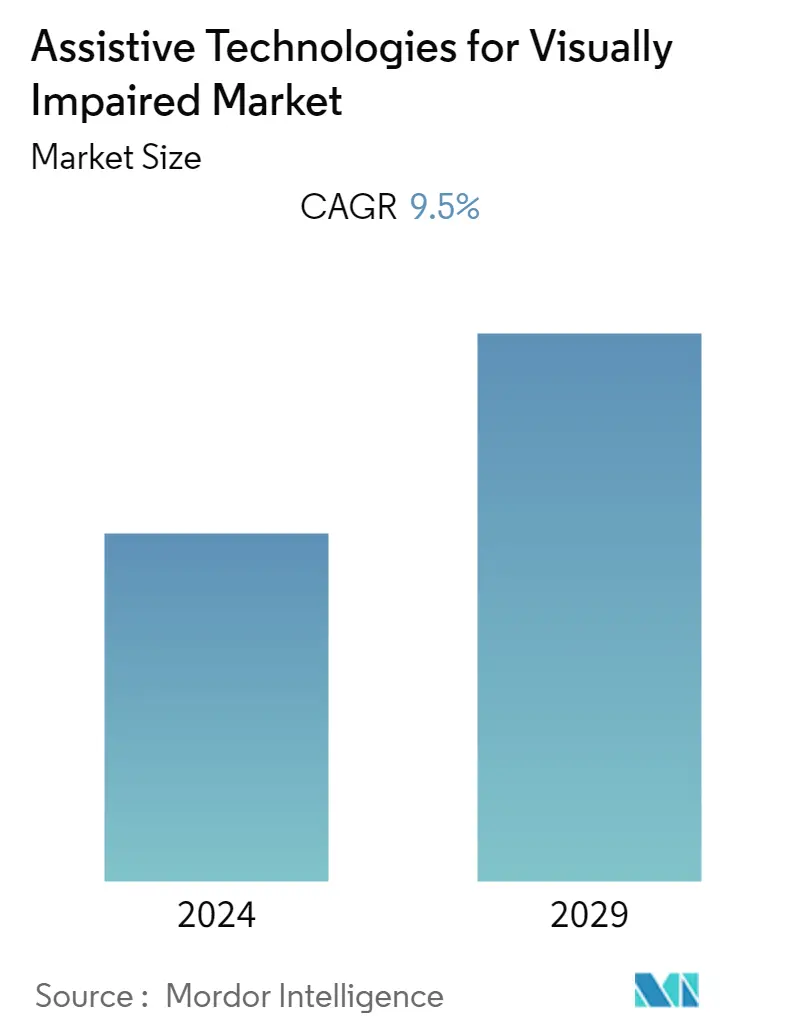Market Size of Assistive Technologies for Visually Impaired Industry

| Study Period | 2019 - 2029 |
| Base Year For Estimation | 2023 |
| CAGR | 9.50 % |
| Fastest Growing Market | Asia-Pacific |
| Largest Market | North America |
| Market Concentration | Medium |
Major Players
*Disclaimer: Major Players sorted in no particular order |
Need a report that reflects how COVID-19 has impacted this market and its growth?
Assistive Technologies for Visually Impaired Market Analysis
The assistive technologies for the visually impaired market are expected to register a CAGR of 9.5% over the forecast period.
The COVID-19 pandemic has had a slight adverse impact on assistive technologies for the visually impaired market initially. With the outbreak of COVID-19, the market for assistive technologies for the visually impaired experienced a slight fall in growth. It was primarily due to the imposition of lockdown and the prioritization of COVID-related and only critical condition treatment. During the pandemic, the risk of COVID-19 infections reduced the number of regular visits by visually impaired patients or students to blind schools, hospitals, etc. This put a halt to their consultation and visual assistance. Although the pandemic was widespread, teleconsultation and virtual classes for visually impaired patients and students helped manage their situations and needs. The study conducted by the American Action Fund for Blind Children and Adults in 2020 and 2021 stated that blind and low-vision students across the United States and Canada shifted from their in-person education mode to the virtual education mode amid the pandemic. However, it was found that in some cases, blind or low-vision students had no access to education due to the lockdown after the COVID-19 outbreak. A study published in the journal Research in Developmental Disabilities in 2021 highlighted the use and efficacy of online interventions for visually impaired children. It was observed that the parents felt reassured by the uninterrupted online treatment of their children. In the post-pandemic era, global unlocking, the availability of vaccines, and control cases of COVID-19 allowed visually impaired patients to get back to their treatment regime and access assistance. For instance, in January 2022, the Ontario Provincial Schools for the Deaf and Blind reopened. In February 2022, the White House administration of the United States announced the guidelines for people with disabilities and older adults in response to and recovery from COVID-19. The guidelines highlighted using appropriate resources and equipment to support in-person learning for children with disabilities. Thus, the COVID-19 outbreak had a slightly adverse impact on the market's growth in its preliminary phase. Moreover, the market is expected to grow further at a stable pace with the reopening of blind schools and the regular visits of visually impaired patients to blind schools, hospitals, and clinics globally.
Further, the high prevalence of visual impairment and blindness globally is boosting the growth of the market. According to the WHO, in October 2022, there will be over 2.2 billion people worldwide living with near or distant vision impairment. In addition, the expanding geriatric population globally will propel market growth. The condition of aging is accompanied by several vision-related disorders and even loss of vision. According to the National Institute on Aging, aging is associated with dry eyes, age-related macular degeneration, diabetic retinopathy, cataracts, and glaucoma. According to a study published in JAMA Ophthalmology in 2022, over 1.49 million people aged 40 years and older are living with late-stage age-related macular degeneration. According to the WHO, people aged 60 and above were recorded at 1 billion, and the number is expected to increase to 1.4 billion in 2030. The market players have launched innovative solutions for visually impaired assistive devices. In August 2021, OrCam launched its latest software, Version 9.10, for its two products, the wearable OrCam MyEye, which is intended for blind and visually impaired individuals, and the handheld OrCam Read, intended for individuals with reading challenges. The latest software would offer an improved experience and better accessibility for the hands-free voice command functions.
Therefore, owing to the high prevalence of visual impairment and blindness and the expanding geriatric population, the studied market is anticipated to witness growth over the analysis period. However, the high cost of electronic visual assistance products is likely to impede market growth.
